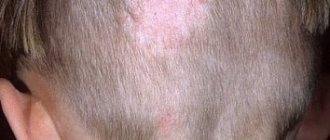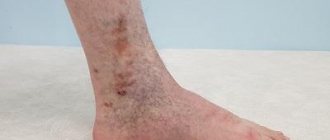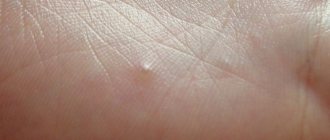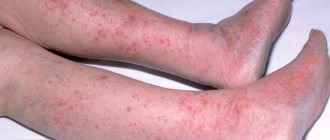Causes of eczema in children
In most cases, eczema in children develops under the simultaneous influence of several factors.
These include:
- the presence of other allergic diseases in the child or his parents (hay fever, bronchial asthma)
- presence of foci of chronic infection (sinusitis, tonsillitis, etc.)
- diseases of the digestive system;
- disruptions in the functioning of the endocrine glands;
- frequent acute respiratory diseases
- excessive reaction to foods
- Coin-shaped
- Dry
- Microbial
- maintain hygiene, regularly bathe the baby in decoctions of chamomile and string;
- exclude foods that provoke allergies from the diet;
- use clothes made from natural fabrics;
- do not allow the skin to rot;
- provide regular walks in the fresh air.
Another cause of eczema in a child is a difficult pregnancy in the mother.
The risk of developing the disease increases significantly if parents or close relatives have a similar problem. If eczema is diagnosed in one parent, then it will appear in the child in 40% of cases. If a similar diagnosis is made to both parents, then this figure increases to 60%.
How to make an appointment with a dermatologist
Eczema in children requires treatment by a dermatologist with regular monitoring of the condition. At JSC "Medicine" (clinic of Academician Roitberg), the appointment is carried out by an experienced specialist, with whom you can make an appointment by phone. Getting your child to the doctor will not be difficult. Convenient location in the center of Moscow allows you to arrive by metro. Nearby are the following stations: “Mayakovskaya”, “Novoslobodskaya”, “Chekhovskaya”, “Belorusskaya”, “Tverskaya”. Be sure to visit a dermatologist for routine and preventive examinations at the address: 2nd Tverskoy-Yamskaya Lane, building 10.
You can also make an appointment on the website using the “Make an appointment with a doctor” form. In it you need to fill in the fields with your name and contact phone number. After sending the application, the clinic administrator will call you back to confirm the date and time of the consultation. At JSC “Medicine” (academician Roitberg’s clinic), a staff of doctors of various specialties works with children who can help examine eczema on the child’s body and prescribe adequate treatment for the baby’s recovery.
Symptoms of childhood eczema
At the initial stage, eczema in children, as seen in the photo, appears in the form of red spots on the cheeks. Later, rashes become noticeable throughout the body, causing severe itching, the skin turns red and becomes swollen.
The severity of symptoms depends on the general health and age of the child, the state of his immune system, and the presence of chronic diseases.
With a mild course of the disease, only minor redness is noticeable and does not cause discomfort. After a few days, the rash resolves and the skin returns to its normal color. The disease can worsen during teething, with increased physical or intellectual stress, after bathing, after eating new food. In children with increased sensitivity, the rash usually merges, occupying large areas.
In severe cases, itching causes severe discomfort in the baby, changes his behavior, causes frequent waking up during sleep and refusal to eat. The child becomes capricious, irritable and nervous, or apathetic and indifferent to everything. He does not want to play with toys, refuses to communicate with friends, relatives and even parents.
Eczema in children can become chronic. In this case, alternating periods of exacerbation and remission are observed. Most often, relapses occur in the autumn-winter period, and also appear after stressful situations. After recovery, there are no active signs of the disease, only severe dry skin remains.
Don't panic if you notice a rash on your baby's skin. In such cases, it is necessary to show it to a doctor. The doctor will examine the little patient, do the necessary tests and make a diagnosis.
You should not allow your child to scratch the affected areas; this can lead to the development of secondary infection and a longer course of the disease.
Prevention of eczema on the head
- The basis of prevention is strict avoidance of contact with allergens. With contact dermatitis, the allergen is usually identified fairly quickly. If you completely remove it, exacerbation can be avoided. For example, if you are allergic to nickel, it is enough not to wear jewelry containing it, and also make sure that the clothing accessories do not come into contact with the skin.
- With atopic dermatitis, there is not always a clear connection between exacerbation and exposure to any allergen. You can apply an elimination diet, in which all potential allergens are first excluded from the menu, and after two weeks, if the skin is completely cleansed, allergenic foods are added to the daily diet one at a time and the condition of the skin is monitored. In this way, it is possible to identify a potentially dangerous product that provokes the disease.
- Avoiding stressful situations, getting enough sleep, breathing exercises and stress management techniques are useful for preventing all types of scalp dermatitis, especially seborrheic dermatitis.
- The skin on the head must be protected from the aggressive effects of environmental factors. Wear a hat in the cold season and a hat or Panama hat on sunny summer days. Use sunscreen. Protect the skin around your eyes with dark glasses.
- You need to wash in warm, but not hot water, for no longer than fifteen minutes. Apply moisturizer to your face immediately after washing your face. This is necessary to prevent moisture loss that occurs when hot water washes away the protective sebaceous layer.
- There is a myth that washing your hair infrequently is beneficial. In fact, you should wash your hair as needed. Poor personal hygiene and greasy hair increase the manifestations of seborrheic eczema.
- All cosmetics must be soft and hypoallergenic. Some components of face cream, shampoo or decorative cosmetics can serve as triggers for exacerbation of eczema. Dyes, fragrances, preservatives, sulfates and surfactants are dangerous. Read the ingredients carefully. To soap, you should prefer special soft foams for washing, hydrophilic oil or milk.
Types of eczema in children
What does eczema look like in children? The answer to this question depends on the type of pathology.
Doctors distinguish several types of eczema in children; the photo clearly shows the differences between them:
Coin-shaped
Coin-shaped plaques form on the skin, which gives the disease its name. The plaques are swollen, wet, and quickly become covered with hard scales that peel off easily at the slightest touch. They can be seen on the legs, buttocks and back. This type of eczema usually appears in older children.
Dry
The disease is manifested by excessive dryness of the skin, especially in the area of the feet and palms, which persists all year round. Over time, microcracks may form.
Dyshidrotic
In 80% of cases, signs of dyshidrotic eczema appear on the child’s hands, and only in 20% of cases the disease affects the feet. Usually diagnosed in children under three years of age.
A characteristic feature of this form of eczema is the presence of blisters filled with clear liquid and most often located on the lateral surfaces of the fingers. Bubbles can be single or combined into groups. After opening them, weeping erosions form.
Microbial
It is provoked by various microorganisms (most often hemolytic streptococcus, epidermal and Staphylococcus aureus) and develops near long-term non-healing wounds, abrasions, scratches in the absence of appropriate antiseptic treatment. Asymmetrical rashes are found on the skin of children, represented by areas of inflammation with the presence of greenish-yellow scale-crusts on the surface.
Seborrheic
The main cause of the disease is a violation of the neuroendocrine system and the reactivity of the body. In children, yellowish-red rashes covered with scales appear on the face and scalp, and sometimes on other parts of the body. The disease is often accompanied by intense itching
Effective treatments for eczema
Cryotherapy
NeoGen procedure
Plasma therapy
One of the fairly common skin diseases is eczema. It is an inflammation accompanied by redness, itching and the appearance of tiny blisters with liquid. It is the latter that explains the name of the disease: such bubbles resemble the boiling of water, from the Greek eczeo means “to boil.”
According to statistics, up to 2% of the world's population suffers from eczema. And in the practice of dermatologists, such pathology occurs in almost 40% of all skin diseases. Most often, patients come with the problem of the appearance of foci of inflammation on the arms, legs, body and head. The rash goes through several stages of development, over time developing from simple redness into weeping erosion and severe peeling. Against the background of such pathology, secondary purulent infections often develop. Without treatment, noticeable cosmetic defects remain on the skin that do not go away over time.
Let's figure out why eczema occurs, how to suspect its development and how such a pathology is treated.
How to treat eczema in a child?
A dermatologist will be able to answer the question of how to treat eczema in a child only after an in-person examination.
First of all, it is necessary to change the diet of the child and mother (if the baby is breastfed): remove spices, seafood, chocolate, sweets, citrus and other tropical fruits, raspberries, strawberries from the diet, and limit salt intake.
You also need to remove synthetic clothing from your wardrobe, protect your baby’s skin from low and high temperatures, and avoid contact with chemicals and other allergens. When washing and bathing, you should use products that do not contain dyes or fragrances.
Importance should be given to normalizing the daily routine. At night, the child should sleep at least 8 hours, and naps during the day are required. For infants, the duration of sleep should be longer. Adequate sleep improves the functioning of the nervous system, strengthens the immune system, and promotes recovery. It is recommended to give the baby air and sun baths more often.
Dermatological diseases of allergic etiology are treated by dermatologists and allergists. But, if the rash appears due to chronic diseases, then you will need to show the child to other specialists: a gastroenterologist, otolaryngologist, neuropsychiatrist or dentist.
Typically, eczema on the hands and feet in children is treated with local medications, including hormonal ones.
In case of secondary infection and suppuration, combination drugs are prescribed, including antibiotics.
Preparations from the Losterin line will help eliminate dryness, flaking and itching. They contain no hormones, fragrances or dyes. Therefore, they do not cause side effects or addiction and are approved for daily long-term use. Products from the Losterin line can be recommended for the treatment of eczema on the hands of a child from three months of age
Losterin cream relieves inflammation and irritation, moisturizes the skin and eliminates the feeling of dryness, accelerates the regeneration of epidermal cells, heals wounds and cracks, and has a moderate antiseptic effect. It is suitable for all skin types and can be used on any area of the body.
Hygiene is important when treating eczema in children. But conventional remedies can worsen the condition. Therefore, it is better to use specialized preparations designed for dry and sensitive skin, for example the Losterin line (shower gel, cream soap and shampoo).
In addition to drug therapy, you can use folk recipes and add decoctions of chamomile, string, sage, St. John's wort, oak bark, starch, and a weak solution of potassium permanganate to the bathing water.
If eczema is severe in a child on the hands and other parts of the body, the signs can be seen in the photo, or if local treatment is ineffective, systemic medications are used, and hospitalization in the children's dermatology department is possible.
Stages of the disease
If we talk about the features of the course of the disease, then there are usually three stages of its development:
- Spicy. It is characterized by the appearance of vesicles on swollen skin, point erosions with weeping, serous crusts, etc. The rashes are multiple in nature.
- Subacute. This stage is characterized by erythema, redness and scaling.
- Chronic. It is characterized by infiltration and strengthening of the “skin pattern”, the appearance of pigmentation.
Symptoms of eczema
Depending on the cause of the disease and the location of the inflammation, symptoms can vary significantly. Most often, patients experience the following manifestations of skin eczema:
- At the erythematous stage, red inflammatory spots appear, which gradually merge with each other.
- At the papular stage, bright red nodules with clear boundaries are formed.
- At the vesicular stage, bubbles with transparent contents appear.
- At the stage of weeping, the bubbles open, point erosions are formed with the release of exudate.
- At the cortical stage, grayish-gray crusts are found, under which the skin heals.
- At the peeling stage, crusts and scales are removed from the surface of the skin.
Symptoms of the disease go away with the elimination of provoking factors. However, the healed area of skin has an uneven color and dense texture.
What other symptoms may indicate the development of eczema:
- The scaly layer at the border of the scalp. Develops with seborrheic eczema. At the initial stage, it manifests itself as single yellowish nodules that quickly grow. Subsequently, a scaly layer forms along the border of the hair.
- Round rashes on hands. Appear in almost 80% of cases of eczema development. At the initial stage they have a rounded shape, but over time they lose it.
- Rashes with clear edges. Most often found on the legs. They can be seen with varicose veins, the rashes have a round shape and pronounced borders.
Symmetrical rashes on the body. They are located all over the body and often peel off. At the initial stages they look typical - they are bubbles with liquid, later areas of thickened skin with severe peeling appear.- Callus-like rashes on the palms. Such formations, especially in places atypical for calluses, also indicate eczema. Bubbles form, but due to the thick skin they may not open.
- Bubbles in the armpit with a hair in the center. Rashes with a hair in the center are a sign of sycosis - damage to the hair follicles. As a rule, such rashes are accompanied by itching and redness.
- Lumps on the face and hands. Such formations do not ooze or crust, and often appear on the face.
- Itchy redness on the arms and legs. Indicate true or microbial eczema. Accompanied by multiple vesicles.
- Suppuration around the wounds. With the development of microbial pathology, purulent crusts and skin hyperemia appear.
The symptoms of eczema are often similar to atopic dermatitis. However, it is worth understanding that pathologies also have significant differences. Dermatitis usually occurs in childhood, while eczema is found in adults and even elderly patients. Another difference is that the first pathology is most often localized on the elbows and knees, neck and face, while eczema can be located on any area, but more often on the hands and legs. Dermatitis occurs suddenly and often disappears. Eczema appears regularly and is often the immediate result of exposure to a specific allergen.
Diagnosis of eczema
The diagnosis is made based on examination and questioning of the patient. In some cases, additional tests may be prescribed to differentiate eczema from other skin diseases. With true eczema, the clinical picture of the disease is typical. In other cases, symptoms may be similar to atopic dermatitis, toxicerma and allergic contact dermatitis.
The diagnostic process may include:
- general blood analysis;
- tissue scraping for examination under a microscope;
- allergy tests to identify the source of allergies;
- histological examination of tissues.
Treatment is prescribed only after confirmation of the diagnosis and determination of the existing type of pathology.
Features of treatment
The key to treating eczema is to identify and minimize triggers. In addition, systemic or local therapy is prescribed, as well as various physiotherapeutic procedures:
- Systemic therapy. It is based on taking antihistamines, which help prevent an acute allergic reaction. Sedatives, glucocorticosteroids and a number of hormonal drugs are also used.
- Local therapy. May include the use of retinol ointment, anti-inflammatory and antiseptic agents. Therapy is selected taking into account the identified form of eczema and the causes of its occurrence. For example, treatment for a virus or fungal infection may be required.
- Physiotherapy. As a rule, it includes ozone therapy, magnetic therapy and laser therapy. In difficult cases, it is possible to treat eczema lesions using cryotherapy. Medicinal and mud baths, exposure to ultraviolet radiation, etc. are often prescribed.
Preventive measures
Diet and lifestyle play an important role in preventing the development of new exacerbations. The diet should exclude any foods that can trigger allergic reactions. Typically this is:
- red berries;
- citrus;
- Fish and seafood;
- chocolate;
- dairy products.
Patients are also advised to give up alcohol and smoking.
Personal hygiene is also important. If eczema of the feet, legs, arms and face develops, it is recommended to avoid scented soaps. Water-based creams can be used to moisturize the skin.
And most importantly, improper treatment of skin diseases can trigger eczema. This means you should not self-medicate. If any rashes and redness appear, do not delay a visit to a dermatologist, because this can be the key to a quick and successful recovery.
If you are faced with the symptoms of eczema and do not know how to get rid of such a disease, then the dermatologists of our KallistoMed clinic are ready to help in this matter. We will be waiting for you at the reception - sign up using the website or by calling the numbers provided!
Bibliography
- Adaskevich, V. P. Itchy skin. Dermatological and interdisciplinary phenomenon / V.P. Adaskevich. - M.: Binom, Panfilov Publishing House, 2014. - 272 p.
- Bork, Conrad Skin diseases. Diagnosis and treatment. Atlas and manual / Conrad Bork, Wolfgang Breuninger. - M.: Medical literature, 2015. - 294 p.
- Barlerin JI. Diagnosis of autoimmune dermatoses.// “Veterinarian”, N5, 6, 1998.-P. 20-23.
- Baumann, Leslie Cosmetic Dermatology. Principles and Practice / Leslie Baumann. — M.: MEDpress-inform, 2016. — 696 p.
- Belikov N.A., Goryainov G.I., Solomennikov A.V. and others // Abstracts. Dokl. IV Rep. Conf. “Sorbents for medical purposes and the mechanisms of their therapeutic action.” Donetsk, 1988. pp. 5-6.
- Zimina I.V. and others. Immunology. N 1. 1994.
- Zudin B.I. Skin and venereal diseases. Textbook. Ed. 2nd, revised and additional - M.: Medicine, 1996, 256 p.
- Masycheva V.I. and others. Wound-healing effect of chitosan.// Veterinary Medicine, 1998, N 7. P. 49-52.
- Eczema and contact dermatitis. - Moscow: SINTEG, 2009. - 965 p.








